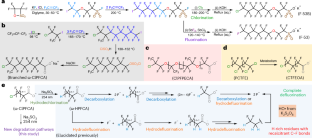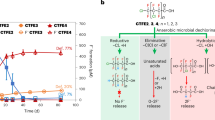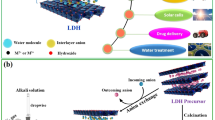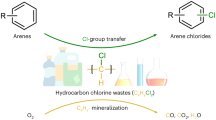Abstract
Chlorinated polyfluoroalkyl substances (Clx–PFAS) are an emerging class of pollutants worldwide. Here we demonstrate near-complete defluorination (that is, cleaving most C–F bonds) of diverse Clx–PFAS structures and the reaction mechanisms. First, we used ultraviolet/sulfite to degrade various carboxylic acids (n = 1, 2, 4 and 8 Cl–CnF2nCOO− and n = 1, 2 and 3 Cl–(CF2CFCl)nCF2COO−) and an ether sulfonic acid surfactant (F-53B, Cl–(CF2)6–O–(CF2)2SO3−). The initial reaction with a hydrated electron cleaved the C–Cl bond. The resulting fluorocarbon radicals (•CF2– on the terminal and –•CF– in the middle) yield C–H or C–SO3−, or form a dimer. In particular, we identified a novel reaction pathway with the unexpected HO• radical to cleave the C–C bond (for –•CF–) and yield –COO−. This pathway is critical for rapid and deep defluorination at 90–96% from carboxylic acids and 76% from F-53B. The following treatment with heat/persulfate at pH >12 achieved ~100% overall defluorination from carboxylic acids and 93% from F-53B without producing toxic ClO3− from Cl−. This study advances the understanding of PFAS transformation in engineering systems. It also suggests a synergy between molecular design and degradation technology towards sustainable management of fluorochemicals.
This is a preview of subscription content, access via your institution
Access options
Subscribe to this journal
Receive 12 digital issues and online access to articles
$99.00 per year
only $8.25 per issue
Buy this article
- Purchase on Springer Link
- Instant access to full article PDF
Prices may be subject to local taxes which are calculated during checkout






Similar content being viewed by others
Data availability
The data that support the findings of this study are available within the paper and its Supplementary Information. Source data for all graphs are provided with this paper. Mass spectrometry raw data are available from the corresponding author upon reasonable request.
References
Key, B. D., Howell, R. D. & Criddle, C. S. Fluorinated organics in the biosphere. Environ. Sci. Technol. 31, 2445–2454 (1997).
Moody, C. A. & Field, J. A. Perfluorinated surfactants and the environmental implications of their use in fire-fighting foams. Environ. Sci. Technol. 34, 3864–3870 (2000).
Wang, Z., DeWitt, J. C., Higgins, C. P. & Cousins, I. T. A never-ending story of per- and polyfluoroalkyl substances (PFASs)? Environ. Sci. Technol. 51, 2508–2518 (2017).
Ng, C. et al. Addressing urgent questions for PFAS in the 21st century. Environ. Sci. Technol. 55, 12755–12765 (2021).
Hanford, W. & Joyce, R. Polytetrafluoroethylene. J. Am. Chem. Soc. 68, 2082–2085 (1946).
Haszeldine, R. New general methods for the synthesis of fluoroiodides and fluoroacids. Nature 166, 192–193 (1950).
Barzen-Hanson, K. A. et al. Discovery of 40 classes of per- and polyfluoroalkyl substances in historical aqueous film-forming foams (AFFFs) and AFFF-impacted groundwater. Environ. Sci. Technol. 51, 2047–2057 (2017).
Begley, T. et al. Perfluorochemicals: potential sources of and migration from food packaging. Food Addit. Contam. 22, 1023–1031 (2005).
Lang, J. R., Allred, B. M., Peaslee, G. F., Field, J. A. & Barlaz, M. A. Release of per- and polyfluoroalkyl substances (PFASs) from carpet and clothing in model anaerobic landfill reactors. Environ. Sci. Technol. 50, 5024–5032 (2016).
Eleuterio, H. Polymerization of perfluoro epoxides. J. Macromol. Sci. A 6, 1027–1052 (1972).
Philips, F. J., Segal, L. & Loeb, L. The application of fluorochemicals to cotton fabrics to obtain oil and water repellent surfaces. Textile Res. J. 27, 369–378 (1957).
Murray, H. & Milton, B. Terminally branched and terminally monochlorinated perfluorocarboxylic acids. US patent US3232970A (1966).
Barnhart, W., Seffl, R., Wade, R., West, F. & Zollinger, J. Physical and chemical properties of a new series of carboxylic acids, Cl (CF2CFCl)xCF2CO2H. Ind. Eng. Chem. Chem. Eng. Data Series 2, 80–83 (2002).
Lau, C., Butenhoff, J. L. & Rogers, J. M. The developmental toxicity of perfluoroalkyl acids and their derivatives. Toxicol. Appl. Pharmacol. 198, 231–241 (2004).
Shi, G. et al. Chronic exposure to 6:2 chlorinated polyfluorinated ether sulfonate acid (F-53B) induced hepatotoxic effects in adult zebrafish and disrupted the PPAR signaling pathway in their offspring. Environ. Pollut. 249, 550–559 (2019).
Yao, J. et al. Novel perfluoroalkyl ether carboxylic acids (PFECAs) and sulfonic acids (PFESAs): occurrence and association with serum biochemical parameters in residents living near a fluorochemical plant in China. Environ. Sci. Technol. 54, 13389–13398 (2020).
Gebbink, W. A., Van Asseldonk, L. & Van Leeuwen, S. P. Presence of emerging per- and polyfluoroalkyl substances (PFASs) in river and drinking water near a fluorochemical production plant in the Netherlands. Environ. Sci. Technol. 51, 11057–11065 (2017).
McCord, J. & Strynar, M. Identification of per- and polyfluoroalkyl substances in the Cape Fear River by high resolution mass spectrometry and nontargeted screening. Environ. Sci. Technol. 53, 4717–4727 (2019).
Washington, J. W. et al. Nontargeted mass-spectral detection of chloroperfluoropolyether carboxylates in New Jersey soils. Science 368, 1103–1107 (2020).
Hauptschein, M. & Braid, M. Halogenated organic compounds. US patent US3002031A (1961).
Wang, S. et al. First report of a Chinese PFOS alternative overlooked for 30 years: its toxicity, persistence, and presence in the environment. Environ. Sci. Technol. 47, 10163–10170 (2013).
Dohany, J. E. Method of preparing high quality vinylidene fluoride polymer in aqueous emulsion. US patent US4360652A (1982).
Perfluoro Sulfonic Acid Group of Shanghai Institute of Organic Chemistry. Perfluoro and polyfluoro sulfonic acids. II. The preparation of some oxapolyfluoroalkane sulfonic acids. Acta Chim. Sinica (in Chinese) 37, 315–324 (1979).
Ti, B., Li, L., Liu, J. & Chen, C. Global distribution potential and regional environmental risk of F-53B. Sci. Total Environ. 640, 1365–1371 (2018).
EFSA Panel on Food Contact Materials, Enzymes and Processing Aids. Scientific opinion on the safety evaluation of the substance perfluoro acetic acid, α‐substituted with the copolymer of perfluoro‐1, 2‐propylene glycol and perfluoro‐1, 1‐ethylene glycol, terminated with chlorohexafluoropropyloxy groups, CAS no. 329238–24‐6 for use in food contact materials. EFSA J. 8, 1519 (2010).
DelRaso, N., Auten, K., Higman, H. & Leahy, H. Evidence of hepatic conversion of C6 and C8 chlorotrifluoroethylene (CTFE) oligomers to their corresponding CTFE acids. Toxicol. Lett. 59, 41–49 (1991).
Huang, L., Dong, W. & Hou, H. Investigation of the reactivity of hydrated electron toward perfluorinated carboxylates by laser flash photolysis. Chem. Phys. Lett. 436, 124–128 (2007).
Park, H. et al. Reductive defluorination of aqueous perfluorinated alkyl surfactants: effects of ionic headgroup and chain length. J Phys. Chem. A 113, 690–696 (2009).
Li, X. et al. Efficient reductive dechlorination of monochloroacetic acid by sulfite/UV process. Environ. Sci. Technol. 46, 7342–7349 (2012).
Cui, J., Gao, P. & Deng, Y. Destruction of per- and polyfluoroalkyl substances (PFAS) with advanced reduction processes (ARPs): a critical review. Environ. Sci. Technol. 54, 3752–3766 (2020).
Bentel, M. J. et al. Defluorination of per- and polyfluoroalkyl substances (PFASs) with hydrated electrons: structural dependence and implications to PFAS remediation and management. Environ. Sci. Technol. 53, 3718–3728 (2019).
Bentel, M. J. et al. Enhanced degradation of perfluorocarboxylic acids (PFCAs) by UV/sulfite treatment: reaction mechanisms and system efficiencies at pH 12. Environ. Sci.Technol. Lett. 7, 351–357 (2020).
Bao, Y., Huang, J., Cagnetta, G. & Yu, G. Removal of F–53B as PFOS alternative in chrome plating wastewater by UV/sulfite reduction. Water Res. 163, 114907 (2019).
Gao, J. et al. Defluorination of omega-hydroperfluorocarboxylates (ω-HPFCAs): distinct reactivities from perfluoro and fluorotelomeric carboxylates. Environ. Sci. Technol. 55, 14146–14155 (2021).
Liu, Z. et al. Near-quantitative defluorination of perfluorinated and fluorotelomer carboxylates and sulfonates with integrated oxidation and reduction. Environ. Sci. Technol. 55, 7052–7062 (2021).
Seppelt, K. Trifluoromethanol, CF3OH. Angew. Chem. Int. Ed. Engl. 16, 322–323 (1977).
Rao, D. et al. New mechanistic insights into the transformation of reactive oxidizing species in an ultraviolet/sulfite system under aerobic conditions: modeling and the impact of Mn(II). ACS ES&T Water 1, 1785–1795 (2021).
Cao, Y., Qiu, W., Li, J., Jiang, J. & Pang, S. Review on UV/sulfite process for water and wastewater treatments in the presence or absence of O2. Sci. Total Environ. 765, 142762 (2021).
Buxton, G. V., Greenstock, C. L., Helman, W. P. & Ross, A. B. Critical review of rate constants forÿreactions of hydrated electrons, hydrogen atoms and hydroxyl radicals (•OH/•O− in aqueous solution. J. Phys. Chem. Ref. Data 17, 513–886 (1988).
Bentel, M. J. et al. Degradation of perfluoroalkyl ether carboxylic acids with hydrated electrons: structure–reactivity relationships and environmental implications. Environ. Sci. Technol. 54, 2489–2499 (2020).
Hauptschein, M. & Braid, M. Fluorocarbon halosulfates and a new route to fluorocarbon acids and derivatives. I. Polyfluoroalkyl chlorosulfates1. J. Am. Chem. Soc. 83, 2500–2505 (1961).
Qian, Y. et al. Perfluorooctanoic acid degradation using UV–persulfate process: modeling of the degradation and chlorate formation. Environ. Sci. Technol. 50, 772–781 (2016).
Yu, X., Ceja-Navarro, J. A. & Wu, X. Sublethal toxicity of fluorine-free firefighting foams in soil invertebrate Caenorhabditis elegans. Environ. Sci. Technol. Lett. 9, 561–566 (2022).
Glüge, J. et al. An overview of the uses of per- and polyfluoroalkyl substances (PFAS). Environ. Sci. Process. Impacts 22, 2345–2373 (2020).
Aberlin, M. E. & Bunton, C. A. Spontaneous hydrolysis of sulfonyl fluorides. J. Org. Chem. 35, 1825–1828 (1970).
Tenorio, R. et al. Destruction of per- and polyfluoroalkyl substances (PFASs) in aqueous film-forming foam (AFFF) with UV-sulfite photoreductive treatment. Environ. Sci. Technol. 54, 6957–6967 (2020).
Wong, G. T. & Zhang, L.-S. Chemical removal of oxygen with sulfite for the polarographic or voltammetric determination of iodate or iodide in seawater. Mar. Chem. 38, 109–116 (1992).
Neta, P., Huie, R. E. & Ross, A. B. Rate constants for reactions of inorganic radicals in aqueous solution. J. Phys. Chem. Ref. Data 17, 1027–1284 (1988).
Menzel, D. W. & Corwin, N. The measurement of total phosphorus in seawater based on the liberation of organically bound fractions by persulfate oxidation. Limnol. Oceanogr. 10, 280–282 (1965).
Liu, J. et al. Reductive defluorination of branched per- and polyfluoroalkyl substances with cobalt complex catalysts. Environ. Sci. Technol. Lett. 5, 289–294 (2018).
Acknowledgements
Financial support was provided by the Strategic Environmental Research and Development Program (ER18-1289 for J.G., Z.L. and J.L., and ER20-1541 for S.C. and Y.M.) and the National Science Foundation (CHE-1709719 for J.L.). S. Wang at Clarkson University provided helpful discussion on the background of F-53B. M. Elsner at the Technical University of Munich provided helpful discussion on the reaction mechanisms.
Author information
Authors and Affiliations
Contributions
J.G. conducted PFAS degradation experiments, analysed the data and drafted the manuscript; Z.L. conducted PFAS degradation experiments; Z.C., D.R. and C.G. measured and analysed electron paramagnetic resonance data; S.C. and Y.M. assisted in the liquid chromatography high-resolution tandem mass spectrometry analysis; J.H. provided F-53B and discussed the manuscript; J.L. designed and supervised the research, and revised the manuscript.
Corresponding author
Ethics declarations
Competing interests
The authors declare no competing interests.
Peer review
Peer review information
Nature Water thanks Zulin Zhang and the other, anonymous, reviewer(s) for their contribution to the peer review of this work.
Additional information
Publisher’s note Springer Nature remains neutral with regard to jurisdictional claims in published maps and institutional affiliations.
Supplementary information
Supplementary Information
Supplementary Figs. 1–3, Tables 1–6 and detailed information on materials and methods, and coordinates of the calculated structures.
Source data
Source Data Fig. 1
All numeric values used to generate the plots in Fig. 1.
Source Data Fig. 2
All numeric values used to generate the plots in Fig. 2.
Source Data Fig. 3
All numeric values used to generate the plots in Fig. 3.
Source Data Fig. 4
All numeric values used to generate the plots in Fig. 4.
Source Data Fig. 5
All numeric values used to generate the plots in Fig. 5.
Rights and permissions
Springer Nature or its licensor (e.g. a society or other partner) holds exclusive rights to this article under a publishing agreement with the author(s) or other rightsholder(s); author self-archiving of the accepted manuscript version of this article is solely governed by the terms of such publishing agreement and applicable law.
About this article
Cite this article
Gao, J., Liu, Z., Chen, Z. et al. Photochemical degradation pathways and near-complete defluorination of chlorinated polyfluoroalkyl substances. Nat Water 1, 381–390 (2023). https://doi.org/10.1038/s44221-023-00046-z
Received:
Accepted:
Published:
Issue Date:
DOI: https://doi.org/10.1038/s44221-023-00046-z
This article is cited by
-
The U-turn on PFAS
Nature Water (2023)
-
The path to complete defluorination of PFAS
Nature Water (2023)



